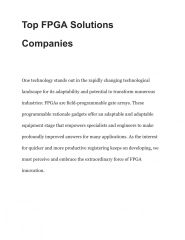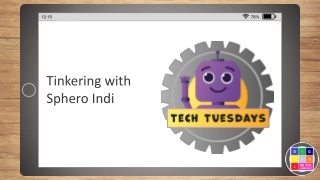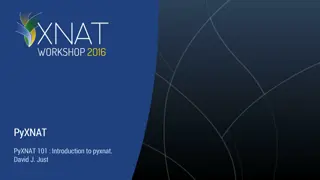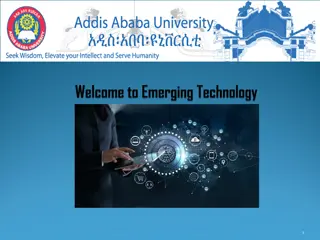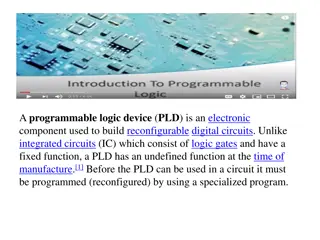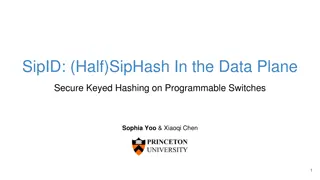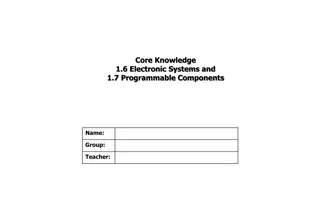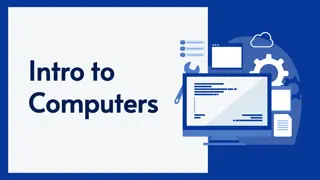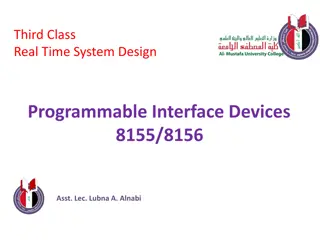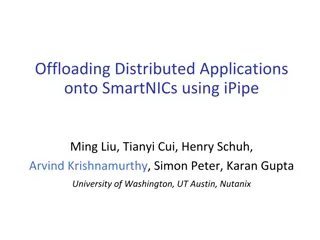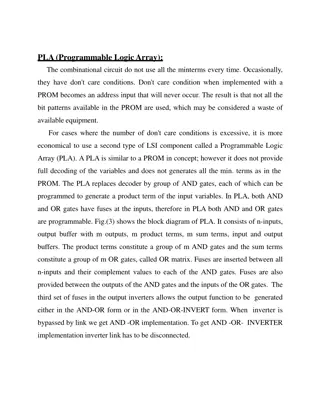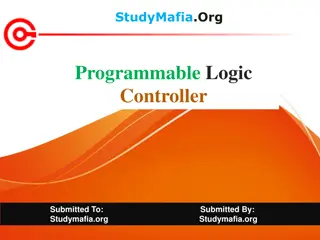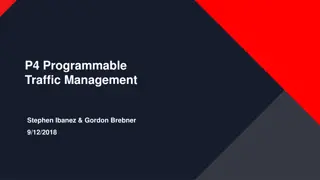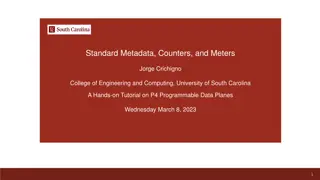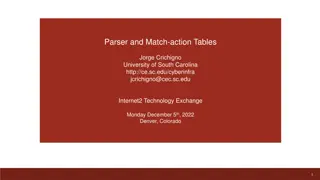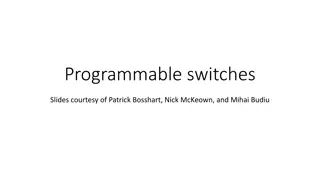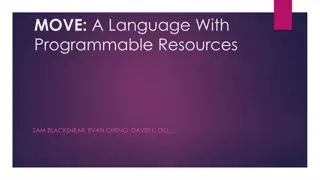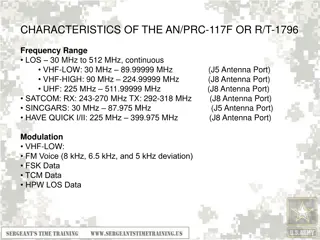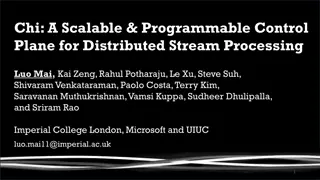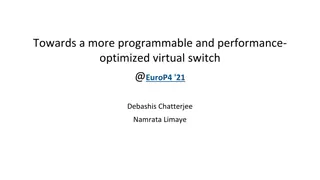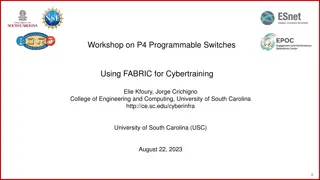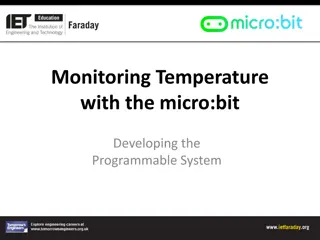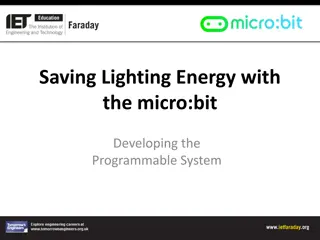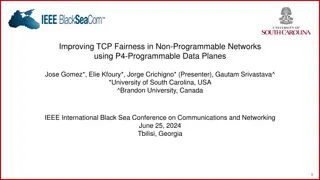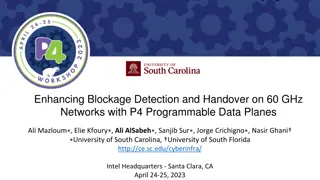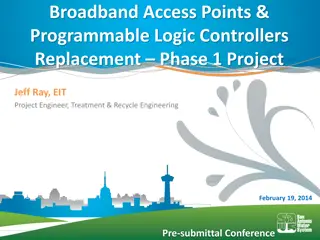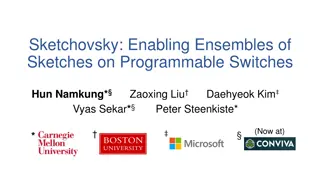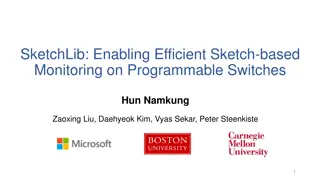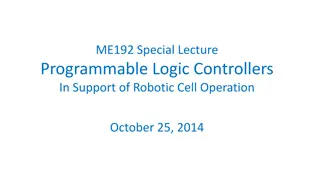Top FPGA Solutions Companies
In the rapidly evolving technological landscape, one technology stands out for its versatility and potential to revolutionize various industries: Field-Programmable Gate Arrays (FPGAs). These programmable logic devices offer a flexible and customizable hardware platform that enables engineers and de
1 views • 1 slides
Tinkering with Sphero Indi
Dive into a bite-sized Tech Tuesday lesson where you'll learn to tinker with Sphero Indi, a programmable robot. Discover the basics of robotics, directional commands, and sequencing paths. Engage in activities like predicting Indi's movements and creating your own paths. Explore cross-curricular app
0 views • 13 slides
Understanding Computer Hardware and Software Fundamentals
A computer is a programmable electronic device consisting of hardware and software that enables input, processing, storage, and output of information. This includes characteristics, basic components, application software, and advanced processing stages like ALU, input/output devices, control unit, R
0 views • 14 slides
Hands-On Training with P4 and Hardware Switches at University of South Carolina
The University of South Carolina offers hands-on training using hardware switches in a cloud system. The system provides remote-access capability to lab equipment for virtual labs on P4, routing, high-speed networks, and cybersecurity. Open-source libraries consist of various activities and experime
0 views • 11 slides
Understanding Computer Organization and Architecture
A computer system is a programmable digital electronics device that processes data as per program instructions to provide meaningful output. It comprises hardware and software components, with hardware being the physical parts and software essential for driving the hardware. Computer organization fo
14 views • 71 slides
System Models in Software Engineering: A Comprehensive Overview
System models play a crucial role in software engineering, aiding in understanding system functionality and communicating with customers. They include context models, behavioural models, data models, object models, and more, each offering unique perspectives on the system. Different types of system
2 views • 33 slides
Virtual Labs on SDN and P4 Programmable Switches
Explore the motivation behind Software-Defined Networking (SDN) and P4 programmable switches, highlighting the shift from traditional networking to more flexible and innovative approaches. Understand how SDN challenges protocol ossification, separates control and data planes, and enables packet-forw
2 views • 47 slides
Introduction to Educational Robotics
Explore the world of educational robotics through activities like programming movement, drawing geometric shapes, and working with self-programmable robots. Learn how to use different tools and techniques to engage in fun and educational robotic activities. Dive into the basics of programming while
1 views • 18 slides
Introduction to PyXNAT: Simplifying Data Interactions with XNAT's REST API
PyXNAT is a Python interface to XNAT's REST API, providing a local programmable interface for accessing and manipulating XNAT's data. It simplifies the process of interacting with XNAT by offering methods for searching, accessing objects, and uploading/downloading files. This introduction covers top
2 views • 14 slides
Evolution of Technologies: A Journey Through Revolutions
Explore the evolution of technologies through different revolutions - from the agricultural revolution to the emerging technologies of the future. Learn about the profound changes in economic relationships and technological conditions that have shaped human society. Discover the role of data, progra
0 views • 58 slides
Understanding Programmable Logic Devices (PLD) in Digital Electronics
Programmable Logic Devices (PLDs) are versatile electronic components used to create reconfigurable digital circuits, distinct from fixed-function integrated circuits. PLDs require programming before use, enabling customization for specific functions. This article explores PLDs, digital electronic s
0 views • 10 slides
Secure Keyed Hashing on Programmable Switches
Explore the implementation challenges and opportunities for improved security, privacy, performance, and reliability in data plane applications using (Half)SipHash and CRC32 hashing techniques. Discover the vulnerabilities associated with CRC32 and the need for secure hashing solutions like SipID. L
0 views • 17 slides
Understanding Electronic Systems and Programmable Components
Dive into the world of electronic systems and programmable components by exploring key terms, sensors like Light Dependent Resistor and Thermistor, control devices, circuit components, and flow charts. Learn about inputs, outputs, feedback loops, and how to design simple routines for controlling out
1 views • 6 slides
Understanding Computers: Key Components and Characteristics
A computer is a programmable electronic device designed to process, store, and retrieve data. This article delves into the key components and characteristics of computers, including hardware, software, data processing, storage, input/output devices, networking, and programming. Computers play essent
0 views • 36 slides
Programmable Interface Devices 8155/8156 Overview and Design Considerations
Explore the capabilities of programmable interface devices 8155/8156 for interfacing I/O devices to microprocessors. Learn about their features, block diagrams, control signals, and address determination. Discover how to design interfacing circuits for reading data from A/D converters using the 8155
0 views • 10 slides
SmartNIC Offloading for Distributed Applications
This presentation discusses offloading distributed applications onto SmartNICs using the iPipe framework. It explores the potential of programmable NICs to accelerate general distributed applications, characterizes multicore SmartNICs, and outlines the development and evaluation process. The study c
0 views • 31 slides
Understanding Programmable Logic Arrays (PLA)
Programmable Logic Arrays (PLAs) provide a flexible way to implement combinational circuits with don't care conditions efficiently. PLAs use programmable AND and OR gates to generate product terms, offering a more economical solution compared to PROMs for circuits with excessive don't care condition
0 views • 19 slides
Understanding Programmable Logic Controllers (PLC)
Programmable Logic Controllers (PLCs) are tiny computers used to control system functions with programmed logic. They receive inputs and provide operating instructions to automate processes in various industries. PLCs have replaced manual relay-based systems and are essential in industrial control t
0 views • 24 slides
Understanding Programmable Traffic Management for Network Optimization
Programmable Traffic Management involves packet scheduling, traffic shaping, policing, drop policies, packet buffering, replication, and classification to optimize network performance. It is used in integrated switch architectures and is crucial for addressing diverse traffic characteristics and req
0 views • 66 slides
Workshop on Fine-grained Measurements App with P4 Programmable Switches
Explore the world of P4 programmable switches in a workshop hosted by the University of South Carolina. Learn about P4, programmable data plane switches, packet parsing, queue monitoring, and applications with P4 switches. Discover the shift from traditional networking to SDN, overcoming limitations
1 views • 19 slides
Understanding Standard Metadata, Counters, and Meters in P4 Programmable Data Planes
Learn about the role of metadata in packet processing, the significance of intrinsic metadata, and how to utilize custom headers for monitoring switch queues in P4 programmable data planes. This tutorial explores the V1 Model standard metadata and provides hands-on experience in defining and using c
0 views • 21 slides
Programmable Parser and Header Definitions at University of South Carolina
Programmable parsers and custom header definitions play a crucial role in network packet processing. This presentation by Jorge Crichigno at the University of South Carolina covers topics such as parser operation, predefined states, and header formats. The content delves into the capabilities of pro
1 views • 22 slides
Evolution of Programmable Switches and Routers
Explore the evolution of programmable switches and routers, from early attempts at programmability to the introduction of the P4 programming language and Software Defined Networking (SDN). Discover the shift towards greater customization and control in network infrastructure, leading to the developm
0 views • 40 slides
MOVE: A Language With Programmable Resources Overview
Move is a language designed by Meta for the Libra blockchain to manage digital assets. It aims to encode and transfer assets in an open system while addressing challenges like asset scarcity and access control. The language, represented through images, introduces the Move Language Definitions and di
0 views • 35 slides
Effective Fuzz Testing for Programmable Logic Controllers - Research for Nuclear Safety
This paper discusses the significance of fuzz testing for Programmable Logic Controllers (PLCs) to ensure nuclear safety, citing incidents like the Stuxnet worm attack. It delves into the methodology, zero-day vulnerability findings, and results of the research conducted by authors in February 2020,
1 views • 11 slides
AN/PRC-117F Characteristics Overview
AN/PRC-117F (or R/T-1796) is a versatile radio system with a frequency range from 30 MHz to 512 MHz, covering VHF-LOW, VHF-HIGH, UHF, SATCOM, SINCGARS, and HAVE QUICK modes. It offers multiple modulation methods, programmable presets, ECCM features, power outputs, and encryption capabilities. With a
0 views • 25 slides
Chi: A Scalable and Programmable Control Plane for Distributed Stream Processing
Distributed stream processing systems are increasingly crucial for various production use cases, such as real-time dashboards, machine learning, and interactive debugging. The challenges of handling large variability in production ingestion workloads and high-degree data skew in queries are addresse
1 views • 20 slides
Towards a More Programmable and Performance-Optimized Virtual Switch @ EuroP4 '21
This presentation discusses the development of a more programmable and performance-optimized virtual switch at EuroP4 '21. It covers topics such as P4 with OVS, challenges in OVS hardware offload, P4 enhanced Open vSwitch, P4 components in OVS, stacked pipelines, and various control and data planes
0 views • 10 slides
Workshop on P4 Programmable Switches Using FABRIC for Cybertraining - University of South Carolina
Explore the world of P4 programmable switches and FABRIC infrastructure for cybertraining at the University of South Carolina. Discover the FABRIC testbed, cybertraining opportunities, organization of labs, and hands-on labs focusing on P4 programmable data planes over FABRIC. Enhance your knowledge
0 views • 13 slides
Developing a Food Temperature Probe with BBC micro:bit
Design and develop a programmable system using the BBC micro:bit to create a prototype food temperature probe. The system should include a temperature sensor to detect food temperature, a buzzer to sound a warning if the food is too cold, and an LED screen to display the food temperature. Follow the
0 views • 9 slides
Developing an Automatic Lighting System with micro:bit
Explore how to save lighting energy with the micro:bit by developing a programmable system for automatic lighting in homes. The project involves using sensors to detect motion, LED lights for illumination, and programming the micro:bit to control the lighting based on occupancy in the room. Get hand
0 views • 8 slides
Enhancing TCP Fairness Using P4-Programmable Data Planes
This study presents a solution to improve TCP fairness in non-programmable networks by utilizing P4-programmable data planes. It addresses unfair bandwidth distribution issues in TCP traffic and proposes a system that leverages P4 switches for passive traffic monitoring and RTT computation.
0 views • 24 slides
Enhancing Blockage Detection and Handover on 60 GHz Networks with P4 Programmable Data Planes
The study presents a system using programmable switches to monitor packet inter-arrival time for blockage detection on mmWave networks. Results show fast recovery speeds and minimal impact on flow completion time, with contributions focusing on leveraging programmable switches and real device scenar
0 views • 7 slides
Broadband Access Points & Programmable Logic Controllers Replacement Phase 1 Project Overview
This project overview provides details of the Broadband Access Points & Programmable Logic Controllers Replacement Phase 1 Project led by Jeff Ray, EIT Project Engineer at Treatment & Recycle Engineering. It includes information on the pre-submittal conference, RFQ schedule, evaluation criteria, and
0 views • 13 slides
Understanding Move Language and Libra Blockchain
Explore Move Language, designed for the Libra Blockchain with programmable resources ensuring safety and expressivity. Learn about Libra's mission to create a stable digital currency and the abstract view of a blockchain system. Discover how Move facilitates encoding digital assets and addresses phy
0 views • 45 slides
Sketchovsky: Enabling Sketch Ensembles on Programmable Switches
Network measurement plays a crucial role in management tasks such as port scan detection and resource provisioning. The concept of sketch ensembles on programmable switches shows promise in addressing key challenges related to control and data plane operations. This approach offers a way to efficien
2 views • 20 slides
Enhancing Efficiency in Sketch-based Monitoring for Programmable Switches
SketchLib introduces advancements in sketching algorithms to enable efficient monitoring on programmable switches. The tool bridges gaps between existing sketches for CPUs and programmable switches, offering resource optimizations and API calls to enhance performance and reduce resource consumption
0 views • 20 slides
NetLogo - Programmable Modeling Environment for Simulating Natural and Social Phenomena
NetLogo is a powerful and versatile programmable modeling environment created by Uri Wilensky in 1999. It allows users to simulate natural and social phenomena by giving instructions to multiple agents operating independently, making it ideal for modeling complex systems evolving over time. NetLogo
0 views • 7 slides
Understanding Programmable Logic Controllers (PLCs) in Robotic Cell Operations
Programmable Logic Controllers (PLCs) are versatile devices used in various industries for automation and control processes. This article explores the functionality and applications of PLCs in supporting robotic cell operations, emphasizing their role in conveyor control, multi-robot workstations, a
0 views • 15 slides
FPGA for Underwater Communication Project Overview
This project, led by Pradyumna (Prad) Kadambi with mentor Cody Youngbull, aims to develop a robust high-speed underwater communication system using Field Programmable Gate Arrays (FPGA). The project addresses the slow and cumbersome nature of current underwater communication methods, with a focus on
0 views • 9 slides
